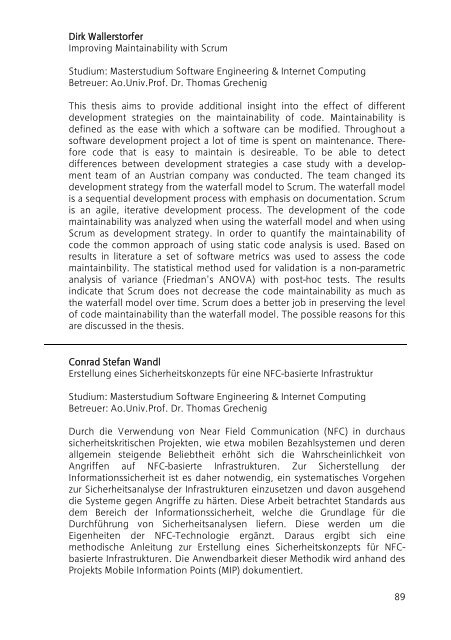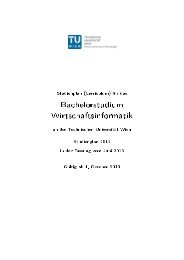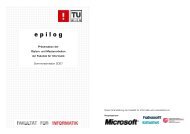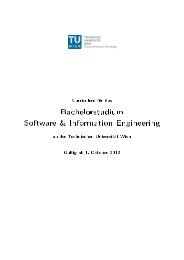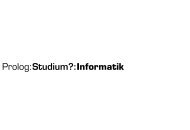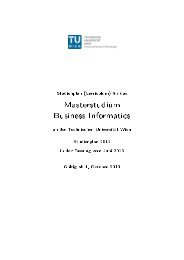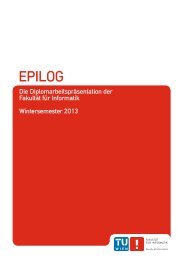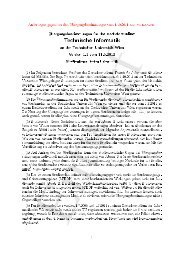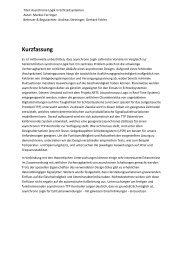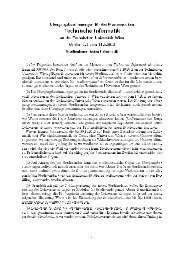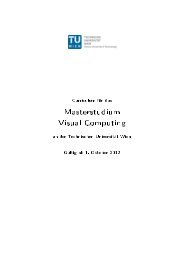Abstract-Band - Fakultät für Informatik, TU Wien - Technische ...
Abstract-Band - Fakultät für Informatik, TU Wien - Technische ...
Abstract-Band - Fakultät für Informatik, TU Wien - Technische ...
Sie wollen auch ein ePaper? Erhöhen Sie die Reichweite Ihrer Titel.
YUMPU macht aus Druck-PDFs automatisch weboptimierte ePaper, die Google liebt.
Dirk Wallerstorfer<br />
Improving Maintainability with Scrum<br />
Studium: Masterstudium Software Engineering & Internet Computing<br />
Betreuer: Ao.Univ.Prof. Dr. Thomas Grechenig<br />
This thesis aims to provide additional insight into the effect of different<br />
development strategies on the maintainability of code. Maintainability is<br />
defined as the ease with which a software can be modified. Throughout a<br />
software development project a lot of time is spent on maintenance. Therefore<br />
code that is easy to maintain is desireable. To be able to detect<br />
differences between development strategies a case study with a development<br />
team of an Austrian company was conducted. The team changed its<br />
development strategy from the waterfall model to Scrum. The waterfall model<br />
is a sequential development process with emphasis on documentation. Scrum<br />
is an agile, iterative development process. The development of the code<br />
maintainability was analyzed when using the waterfall model and when using<br />
Scrum as development strategy. In order to quantify the maintainability of<br />
code the common approach of using static code analysis is used. Based on<br />
results in literature a set of software metrics was used to assess the code<br />
maintainbility. The statistical method used for validation is a non-parametric<br />
analysis of variance (Friedman's ANOVA) with post-hoc tests. The results<br />
indicate that Scrum does not decrease the code maintainability as much as<br />
the waterfall model over time. Scrum does a better job in preserving the level<br />
of code maintainability than the waterfall model. The possible reasons for this<br />
are discussed in the thesis.<br />
Conrad Stefan Wandl<br />
Erstellung eines Sicherheitskonzepts <strong>für</strong> eine NFC-basierte Infrastruktur<br />
Studium: Masterstudium Software Engineering & Internet Computing<br />
Betreuer: Ao.Univ.Prof. Dr. Thomas Grechenig<br />
Durch die Verwendung von Near Field Communication (NFC) in durchaus<br />
sicherheitskritischen Projekten, wie etwa mobilen Bezahlsystemen und deren<br />
allgemein steigende Beliebtheit erhöht sich die Wahrscheinlichkeit von<br />
Angriffen auf NFC-basierte Infrastrukturen. Zur Sicherstellung der<br />
Informationssicherheit ist es daher notwendig, ein systematisches Vorgehen<br />
zur Sicherheitsanalyse der Infrastrukturen einzusetzen und davon ausgehend<br />
die Systeme gegen Angriffe zu härten. Diese Arbeit betrachtet Standards aus<br />
dem Bereich der Informationssicherheit, welche die Grundlage <strong>für</strong> die<br />
Durchführung von Sicherheitsanalysen liefern. Diese werden um die<br />
Eigenheiten der NFC-Technologie ergänzt. Daraus ergibt sich eine<br />
methodische Anleitung zur Erstellung eines Sicherheitskonzepts <strong>für</strong> NFCbasierte<br />
Infrastrukturen. Die Anwendbarkeit dieser Methodik wird anhand des<br />
Projekts Mobile Information Points (MIP) dokumentiert.<br />
89


